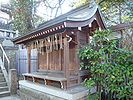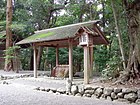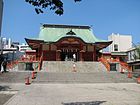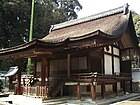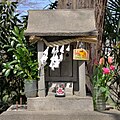Shinto architecture
Shinto architecture is the architecture of Japanese Shinto shrines.
With a few exceptions like
The composition of a Shinto shrine is extremely variable, and none of its possible features are necessarily present. Even the honden or sanctuary, the part which houses the kami and which is the centerpiece of a shrine, can be missing. However, since its grounds are sacred, they usually are surrounded by a fence made of stone or wood called tamagaki, while access is made possible by an approach called sandō. The entrances themselves are straddled by gates called torii, which are therefore the simplest way to identify a Shinto shrine.
A shrine may include within its grounds several structures, each destined to a different purpose.
Before the forced separation of Shinto and Buddhism (
The origin of shrines
The practice of marking sacred areas began in Japan as early as the
Common features

The following is a diagram illustrating the most important elements of a Shinto shrine:
- Torii – Shinto gate
- Stone stairs
- Sandō – the approach to the shrine
- Chōzuya or temizuya – fountain to cleanse one's hands and face
- Tōrō– decorative stone lanterns
- Kagura-den – building dedicated to Nō or the sacred kagura dance
- Shamusho – the shrine's administrative office
- Ema– wooden plaques bearing prayers or wishes
- Sessha/massha – small auxiliary shrines
- Komainu – the so-called "lion dogs", guardians of the shrine
- Haiden – oratory
- Tamagaki – fence surrounding the honden
- Honden – main hall, enshrining the kami.
- On the roof of the haiden and honden are visible finials) and katsuogi(short horizontal logs), both common shrine ornamentations.
Gate (torii)
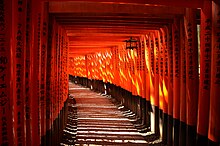
The torii is a gate which marks the entrance to a sacred area, usually but not necessarily a shrine.[12] A shrine may have any number of torii (Fushimi Inari Taisha has thousands) made of wood, stone, metal, concrete or any other material. They can be found in different places within a shrine's precincts to signify an increased level of holiness.[12]
Torii can often be found also at Buddhist temples, however they are an accepted symbol of Shinto, and as such are used to mark shrines on maps.
The origin of the torii is unclear, and no existing theory has been accepted as valid.[12] They may for example have originated in India as a derivative of the torana gates in the monastery of Sanchi, which is located in central India.[13]
Pathway (sandō)
The sandō is the road approaching either a Shinto shrine or a Buddhist temple.[14] Its point of origin is usually straddled in the first case by a Shinto torii, in the second by a Buddhist sanmon, gates which mark the beginning of the shrine's or temple territory. There can also be stone lanterns and other decorations at any point along its course. There can be more than one sandō, in which case the main one is called omote-sandō, or front sandō, ura-sandō, or rear sandō, etc.
Fountain (chōzuya)
Before entering the shrine, visitors are supposed to wash their hands and mouths at a fountain built to the purpose called chōzuya or temizuya.
Guardian lion-dogs (komainu)
The two "lions" in front of a shrine are in effect warden dogs called
Worship hall (haiden)
The haiden is the hall of worship or oratory of the shrine. It is generally placed in front of the shrine's main sanctuary (honden) and often built on a larger scale than the latter. The haiden is often connected to the honden by a heiden, or hall of offerings. While the honden is the place for the enshrined kami and off-limits to the general public, the haiden provides a space for ceremonies and for worshiping the kami.[17][18]
Offertory hall (heiden)
The heiden is the part of a shrine used to house offerings, and normally consists of a section linking the honden and the haiden .[19] It can also be called chūden (中殿) or in other ways, and its position can sometimes vary. In spite of its name, nowadays it is used mostly for rituals.
Sanctuary (honden)
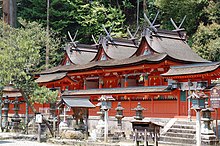
The honden, also called shinden (神殿) is the most sacred building of shrine, intended purely for the use of the enshrined kami. The kami, in itself incorporeal, is usually represented physically by a mirror or sometimes by a statue.[20] The building is normally in the rear of the shrine and closed to the general public. The sections Most common shrine styles and Other styles below are dedicates specifically to honden and their characteristics.
Other elements
Hokora
A hokora or hokura is a very small Shinto shrine either found on the precincts of a larger shrine and dedicated to folk kami, or on a street side, enshrining kami not under the jurisdiction of any large shrine.[21] Dōsojin, minor kami protecting travelers from evil spirits, may for example be enshrined in a hokora.[21]
Sessha, massha
Sessha (摂社, 'auxiliary shrine') and massha (末社, 'branch shrine'), also called eda-miya (枝宮)[14] are small or miniature shrines having a deep historical relationship with a more important shrine or with the kami it enshrines, and fall under that shrine's jurisdiction.[22] The two terms used to have different meanings, but must be today considered synonyms. For this reason, this kind of shrine is now sometimes called setsumatsusha (摂末社).[note 2]
Most common shrine styles
Shrine buildings can have many different basic layouts, usually named either after a famous shrine's honden (e.g. hiyoshi-zukuri, named after Hiyoshi Taisha), or a structural characteristic (e.g. irimoya-zukuri, after the hip-and-gable roof it adopts. The suffix -zukuri in this case means "structure".)
The honden's roof is always gabled, and some styles also have a veranda-like aisle called
- hirairi or hirairi-zukuri (平入・平入造) – a style of construction in which the building has its main entrance on the side which runs parallel to the roof's ridge (non gabled-side). The shinmei-zukuri, nagare-zukuri, hachiman-zukuri, and hie-zukuri belong to this type.[22]
- tsumairi or tsumairi-zukuri (妻入・妻入造) – a style of construction in which the building has its main entrance on the side which runs perpendicular to the roof's ridge (gabled side). The taisha-zukuri, sumiyoshi-zukuri, ōtori-zukuri and kasuga-zukuri belong to this type.[22]
Proportions are also important. A building of a given style often must have certain proportions measured in
The oldest styles are the tsumairi shinmei-zukuri, taisha-zukuri, and sumiyoshi-zukuri, believed to predate the arrival of Buddhism.[22]
The two most common are the hirairi nagare-zukuri and the tsumairi kasuga-zukuri.[23] Larger, more important shrines tend to have unique styles.
Nagare-zukuri

The nagare-zukuri (流造, 'flowing style') or nagare hafu-zukuri (流破風造, 'flowing gabled style') is a style characterized by a very asymmetrical gabled roof (切妻屋根 kirizuma-yane in Japanese) projecting outwards on the non-gabled side, above the main entrance, to form a portico.[23] This is the feature which gives the style its name, the most common among shrines all over the country.
Sometimes the basic layout consisting of an elevated core (母屋,
Kasuga-zukuri
After the Nagare-zukuri, this is the most common style, with most instances in the Kansai region around Nara.[23]
Other styles
Follows a list of other styles (in alphabetical order). Many are rare, some unique. Most deal with the structure of a single building but others, for example the Ishi-no-ma-zukuri style, define instead the relationship between member structures. In that case, the same building can fall under two separate classifications. For example, the honden and haiden at Ōsaki Hachimangū are single-storied, irimoya-zukuri edifices.[26] Because they are connected by a passage called ishi-no-ma and are covered by a single roof, however, the complex is classified as belonging to the ishi-no-ma-zukuri'style (also called gongen-zukuri).
Gongen-zukuri
The name comes from Nikkō Tōshō-gū in Nikkō because it enshrines the Tōshō Daigongen (Tokugawa Ieyasu).
Hachiman-zukuri
Hachiman-zukuri (八幡造) is a style used at Hachiman shrines in which two parallel structures with gabled roofs are interconnected on the non-gabled side, forming one building which, when seen from the side, gives the impression of two.[27] The front structure is called gaiden (外殿, outer sanctuary), the rear one naiden (内殿, inner sanctuary), and together they form the honden.[14] There are entrances at the center of the non-gabled side. In general, the rear structure is 3 × 2 ken, while the front one is 3 × 1.
The space between the two structures is one The actual width and height of this room vary with the shrine.
Extant examples are
Hiyoshi-zukuri
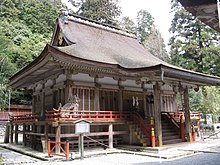
The building is composed of a 3x2 The roof on the back has a peculiar and characteristic shape.
Irimoya-zukuri
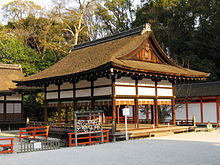
The name derives from its hip and gable roof (入母屋屋根, irimoya yane). In Japan the gable is right above the edge of the shrine's moya, while the hip covers the hisashi.
Ishi-no-ma-zukuri
Ishi-no-ma-zukuri (石の間造), also called gongen-zukuri (権現造), yatsumune-zukuri (八棟造) and miyadera-zukuri (宮寺造) is the name of a complex shrine structure in which the haiden, or worship hall, and the honden, or main sanctuary, are interconnected under the same roof in the shape of an H.[31]
The connecting passage can be called ai-no-ma (相の間), ishi-no-ma (石の間), or chūden (中殿, intermediate hall).[31] The floor of each of the three halls can be at a different level. If the ai-no-ma is paved with stones it is called ishi-no-ma, whence the name of the style. It can, however, be paved with planks or tatami. Its width is often the same as the honden's, with the haiden from one to three ken wider.[31]
One of the oldest examples is
Kibitsu-zukuri

Misedana-zukuri
Misedana-zukuri (見世棚造 or 店棚造, showcase style) owes its name to the fact that, unlike the other shrine styles, it doesn't feature a stairway at the entrance, and the veranda is completely flat.
Ōtori-zukuri
The Ōtori-zukuri (大鳥造) is a tsumairi style named after
Owari-zukuri

Owari-zukuri (尾張造) is a complex style found in large shrines of what used to be called
Primitive shrine layout without honden
This style is rare, but historically important. It is also unique in that the
Ryōnagare-zukuri
Ryōnagare-zukuri (両流造, double flow style) is an evolution of the nagare-zukuri in which the roof flows down to form a portico on both non-gabled sides.[23] Examples are the honden at Itsukushima Shrine and at Matsuo Taisha.

Shinmei-zukuri
Shinmei-zukuri (神明造) is an ancient style typical of, and most common at Ise Grand Shrine, the holiest of Shinto shrines.[23] It is most common in Mie prefecture.[35] Characterized by an extreme simplicity, its basic features can be seen in Japanese architecture from the Kofun period (250–538 C.E.) onwards and it is considered the pinnacle of Japanese traditional architecture. Built in planed, unfinished wood, the honden is either 3x2 ken or 1x1ken in size, has a raised floor, a gabled roof with an entry on one the non-gabled sides, no upward curve at the eaves, and decorative logs called chigi and katsuogi protruding from the roof's ridge.[35] The oldest extant example is Nishina Shinmei Shrine, the shrine which gives the style its name.[22]
Sumiyoshi-zukuri
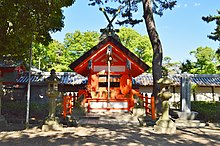
Construction is simple, but the pillars are painted in vermilion and the walls in white.
The style is supposed to have its origin in old palace architecture
Taisha-zukuri
The honden normally has a 2x2 ken footprint (12.46x12.46 m in Izumo Taisha's case), with an entrance on the gabled end. The stairs to the honden are covered by a cypress bark roof. The oldest extant example of the style is
Gallery
-
A metal torii
-
A sandō
-
A temizuya
-
A komainu
-
Izumo Taisha's honden
-
Hanazono Jinja's haiden
-
Kasuga Taisha's heiden
-
Hirairi style: entrance on the non-gabled side
-
The typical shape of the back of a Hiyoshi-zukuri roof
-
A hokora
-
Ōtori-zukuri
-
Ōtori Taisha's honden
-
Some setsumatsusha
-
Shinmei-zukuri
-
Sumiyoshi-zukuri
-
Taisha-zukuri,Izumo Taisha
See also
Notes
- ^ Presently only the Ise Grand Shrine is being rebuilt every 20 years.
- ^ The term setsumatsusha is the combination of the two terms sessha and massha.
- Lotus SūtraHall. A hall whose layout allows walking around a statue for meditation
- ^ A hip roof, or hipped roof, is a type of roof where all sides slope downwards to the walls, usually with a fairly gentle slope.
- ^ A gable is the generally triangular portion of a wall enclosed between the edges of a sloping roof.
References
- ^ a b c The History of Shrines, Encyclopedia of Shinto, retrieved on June 10, 2008
- ^ Mark Teeuwen in Breen and Teeuwen (2000:95-96)
- ^ a b c d Young & Young 2007, p. 50
- ^ a b c Fletcher & Cruickshank 1996, p. 724
- ^ a b Nishi & Hozumi 1996, p. 40
- ^ a b Kishida 2008, p. 33
- ^ Kishida 2008, p. 34
- ^ Kishida 2008, p. 35
- ^ Kishida 2008, p. 126
- ^ Nishi & Hozumi 1996, p. 41
- ^ Kuroda 2005
- ^ a b c Encyclopedia of Shinto Torii, accessed on December 15, 2009
- ^ a b JAANUS, Torii accessed on December 12, 2009
- ^ a b c Iwanami Kōjien (広辞苑) Japanese dictionary, 6th Edition (2008), DVD version.
- ^ a b JAANUS, Komainu, accessed on November 8, 2009
- ^ JAANUS, A un, accessed on November 8, 2009
- ^ Mori, Mizue (2005-06-02). "Haiden". Encyclopedia of Shinto (β1.3 ed.). Tokyo: Kokugakuin University. Retrieved 2009-11-16.
- JAANUS - Japanese Architecture and Art Net User System. Retrieved 2009-11-08.
- JAANUS, accessed on November 17, 2009
- ^ Shinden, Encyclopædia Britannica
- ^ a b Encyclopedia of Shinto, Hokora. Accessed on December 14, 2009
- ^ a b c d e "Sessha - Massha" (in Japanese). Yahoo! Japan. Archived from the original on 19 December 2012. Retrieved 5 December 2009.
- ^ a b c d e f g h i j k l m Encyclopedia of Shinto,History and Typology of Shrine Architecture, accessed on November 29, 2009
- ^ a b JAANUS, Nagare-zukuri, accessed on December 1, 2009
- ^ a b JAANUS, Kasuga-zukuri, accessed on December 1, 2009
- Ōsaki Hachiman Shrine. Archived from the original(PDF) on 2011-07-22. Retrieved 2009-11-04.
- ^ a b c d JAANUS, Hachiman-zukuri accessed on December 1, 2009
- ^ JAANUS, Hie-zukuri, accessed on December 1, 2009
- ^ a b c JAANUS, Irimoya-zukuri, accessed on December 1, 2009
- ^ Iwanami Nihonshi Jiten (岩波日本史辞典), CD-Rom Version. Iwanami Shoten, 1999-2001.
- ^ a b c d Encyclopedia of Shinto, Gongen-zukuri accessed on December 2, 2009
- ^ Jaanus, Gongen-zukuri, accessed on December 5, 2009
- ^ JAANUS, Misedana-zukuri, accessed on December 1, 2009.
- ^ a b c JAANUS, Ootori-zukuri, accessed on December 1, 2009
- ^ a b JAANUS, Shinmei-zukuri accessed on December 1, 2009
- ^ Jinja Kenchiku, Shogakukan Nihon Daihyakka Zensho, accessed on November 29, 2009
- ^ a b c JAANUS, Sumiyoshi-zukuri, accessed on December 1, 2009
- ^ JAANUS, Taisha-zukuri, accessed on December 1, 2009
Bibliography
- ISBN 0-7506-2267-9. Retrieved 2009-11-11.
- Kishida, Hideto (2008). Japanese Architecture. READ BOOKS. ISBN 978-1-4437-7281-5. Retrieved 2009-11-11.
- Kuroda, Ryūji (2005-06-02). "History and Typology of Shrine Architecture". Encyclopedia of Shinto (β1.3 ed.). Tokyo: Kokugakuin University. Retrieved 2009-11-16.
- Nishi, Kazuo; Hozumi, Kazuo (1996) [1983]. What is Japanese architecture? (illustrated ed.). Kodansha International. ISBN 4-7700-1992-0. Retrieved 2009-11-11.
- Watanabe, Yasutada (1974). Shinto art: Ise and Izumo shrines. New York, Tokyo: Weatherhill/Heibonsha.
- Young, David; Young, Michiko (2007) [2004]. The art of Japanese architecture. Architecture and Interior Design (illustrated, revised ed.). Tuttle Publishing. ISBN 978-0-8048-3838-2. Retrieved 2009-11-11.

